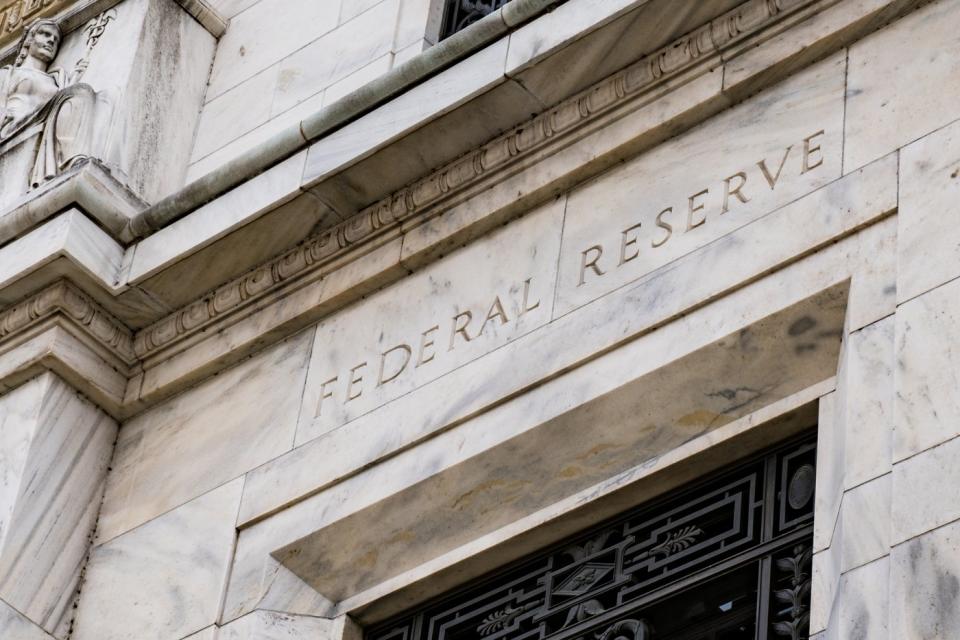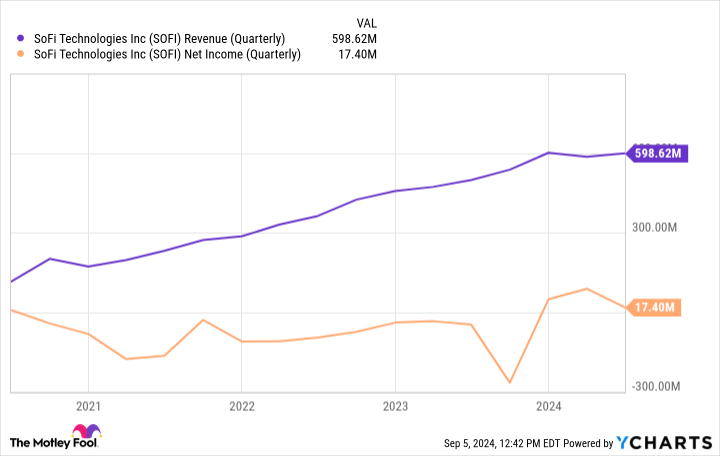Two weeks ago, Wall Street and retail investors alike held their breath as Federal Reserve Chairman Jerome Powell took the stage at the Economic Symposium in Jackson Hole, Wyoming. While the investment community listened to Powell’s every word, the following remark seems to have resonated well: “The time has come for policy to adjust.”
I’m going to go out on a limb here and posit that the Fed is (finally!) going to begin reducing interest rates. Such a change to monetary policy would be welcomed by many types of businesses.
In particular, I see fintech platform SoFi (NASDAQ: SOFI) as an obvious beneficiary of lower interest rates. An integral part of Cathie Wood’s Ark Invest Management portfolio, SoFi stock has been decimated this year. After cratering 26% so far in 2024, SoFi shares currently trade for just $7.
Let’s dig into what’s going on with SoFi’s business and assess how the company is so exposed to interest rates. With changes to monetary policy looking likely, now could be a time to buy the dip in SoFi stock hand over fist.
Taking a look at SoFi’s entire business
SoFi breaks its business down into three primary segments: lending, technology, and financial services. As the chart below indicates, SoFi has done an impressive job growing its revenue over the last few years. More importantly, the company has also demonstrated that it’s moved on from operating losses and is on a path to generate consistently positive net income. Pretty good stuff, right? Well, maybe not.
Despite SoFi’s overall relative strength, there is one blemish with the company’s operation. Lending services is by far SoFi’s biggest source of growth. The problem is that the lending segment has shown noticeable deceleration throughout 2024. For the six months ended June 30, SoFi’s lending business generated a total of $664 million in net revenue — only a 3% increase year over year.
I can see how slowing growth in a company’s main source of revenue wouldn’t bode well for investor confidence. I’d caution investors from hitting the panic button, though. There are still a couple of important ideas to explore before writing off SoFi’s prospects.
How would lower rates impact SoFi?
Rising interest rates don’t just make the cost of capital more expensive; they can also have a true ripple effect on the economy at large. Businesses and consumers may not be able to access loans at higher rates or will simply choose not to get a loan even if their credit meets a bank’s underwriting protocols. Considering SoFi’s largest business is lending services, it’s not too surprising to see this segment come to a screeching halt during a period of elevated interest rates.
However, given the recent remarks from Chairman Powell, I think it’s likely that the Fed is going to start lowering rates soon — and I’m not alone in this prediction. Investment banks including Goldman Sachs, Bank of America, JP Morgan, Wells Fargo, Morgan Stanley, and Citigroup are all forecasting a rate cut in September.
Lowering rates could serve as a bellwether for lending businesses. As a result, I see a Fed rate cut as a major catalyst for SoFi and one that can help supercharge the company’s performance. Specifically, I see refinancing in student loans and mortgages as well as home equity loans as three use cases that could see some rejuvenated activity for SoFi.
Now, although lower rates should theoretically inspire an uptick in lending activity, it’s important to assess the magnitude by which this dynamic impacts SoFi’s business. During the second-quarter earnings call, SoFi CEO Anthony Noto explained that when the economy eventually enters a lower interest rate environment, SoFi will still “maintain a high rate relative to our competition.” He went on to say that
as rates go down, the value of our loans generally go up, all else equal, and so we can maintain a superior APY. That doesn’t mean we may not change it. It just means it will be superior to drive our differentiated value proposition and leverage our competitive advantage.
What Noto is saying is that even when rates come down, SoFi can maintain higher coupons relative to the competition due to the company’s diversified platform, which offers users a multitude of financial-services products — with lending being just one of them. In his eyes, SoFi should witness an uptick in volume in its lending business while also maintaining strong unit economics despite reduced interest rates.

Why now looks like the time to load up on SoFi
One thing that I find interesting about SoFi’s current trading activity is that the stock has gone down during a period when the company has transitioned from consistently burning cash to enjoying a profitable enterprise. Moreover, SoFi has managed to turn consistent profits while its largest source of growth (lending) has basically remained flat. A big reason for this is that the company’s strategy to cross-sell other products and services throughout its ecosystem is paying off in spades.
At the end of June, SoFi boasted 8.8 million members on its platform — up 41% year over year. Among this user base, 12.8 million products are being utilized. This means that each SoFi member is using 1.5 services on average. This dynamic makes it easier to keep costs related to customer acquisition reasonable, while simultaneously achieving higher unit economics across the entire customer base. Still, I don’t think investors are fully appreciating this dynamic, and they have gone so far as to punish SoFi in the form of heavy stock sell-offs.
Considering rate cuts should inspire newfound activity for lending businesses at large, I would think SoFi is in a pretty solid position to witness even more accelerated growth across the top and bottom lines. In other words, I actually think SoFi’s current profitability profile is quite a bit below what it could be once the lending business returns to normal growth levels. I think the business is largely misunderstood, and investors are discounting the tailwind that rate cuts represent for future growth. For all of these reasons, I think investing in SoFi right now is a no-brainer.
Should you invest $1,000 in SoFi Technologies right now?
Before you buy stock in SoFi Technologies, consider this:
The Motley Fool Stock Advisor analyst team just identified what they believe are the 10 best stocks for investors to buy now… and SoFi Technologies wasn’t one of them. The 10 stocks that made the cut could produce monster returns in the coming years.
Consider when Nvidia made this list on April 15, 2005… if you invested $1,000 at the time of our recommendation, you’d have $630,099!*
Stock Advisor provides investors with an easy-to-follow blueprint for success, including guidance on building a portfolio, regular updates from analysts, and two new stock picks each month. The Stock Advisor service has more than quadrupled the return of S&P 500 since 2002*.
*Stock Advisor returns as of September 9, 2024
JPMorgan Chase is an advertising partner of The Ascent, a Motley Fool company. Wells Fargo is an advertising partner of The Ascent, a Motley Fool company. Bank of America is an advertising partner of The Ascent, a Motley Fool company. Citigroup is an advertising partner of The Ascent, a Motley Fool company. Adam Spatacco has positions in SoFi Technologies. The Motley Fool has positions in and recommends Bank of America, Goldman Sachs Group, and JPMorgan Chase. The Motley Fool has a disclosure policy.
Rate Cuts Are Coming: 1 No-Brainer Cathie Wood Fintech Stock to Buy Hand Over Fist Right Now for Just $7 was originally published by The Motley Fool
Source link
 meganwoolsey Home
meganwoolsey Home




